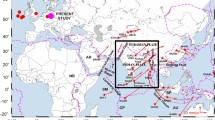Abstract
The Amurian plate (AM) in Northeast Asia plays a particularly important role in the estimation of surrounding crustal movements and interpretation of seismic activities, especially in southwest Japan. However, the existence of the Amurian plate and the location of the southern boundary remain controversial. Due to insufficient data, the southern boundary is not well known and often assumed to cross the Southern Korean Peninsula. Therefore, this area is critical to further accurately define the Amurian plate geometry. The existing permanent Korean GPS network (KGN) with more than 45 GPS sites plays a key role to discriminate the southern boundary of the Amurian plate near South Korea. Data for the period from March 2000 to August 2003 are analyzed together with data from IGS and some Chinese GPS stations. Estimated velocities show that South Korea is almost rigid and the southern boundary of the Amurian plate may not cross South Korea. Using the F-ratio statistical test, we determine whether South Korea belongs to the Amurian or South China plates. The test has shown that the Southern Korean Peninsula neither resides on the Amurian plate as hypothesized, nor is part of the South China block.
Similar content being viewed by others
References
Altamimi Z., Sillard P. and Boucher C., 2002. ITRF2000: A new release of the International Terrestrial Reference Frame for earth science applications. J. Geophys. Res., 107, 2214, doi: 10.1029/2001JB000561.
Beutler G., Rothacher M., Schaer S., Springer T.A., Kouba J. and Neilan R.E., 1999. The International GPS Service (IGS): an interdisciplinary service in support of earth sciences. Adv. Space Res., 23, 631–635.
Bird P., 2003. An updated digital model of plate boundaries. Geochem. Geophys. Geosyst., 4, 1027, doi: 10.1029/2001GC000252.
Calais E., Vergnolle M., San’kov V., Lukhnev A., Miroshnitchenko A., Amarjargal S. and Deverchere J., 2003. GPS measurements of crustal deformation in the Baikal-Mongolia area (1994–2002): Implications for current kinematics of Asia. J. Geophys. Res., 108, 2501, doi: 10.1029/2002JB002373.
Ernst W.G., Cao R. and Jiang J., 1988. Reconnaissance study of Precambrian metamorphic rocks, northwestern Sino-Korean shield, Peoples Republic of China. Geol. Soc. Am. Bull., 100, 692–701.
Heki K., Miyazaki S., Takahashi H., Kasahara M., Kimata F., Miura S. and An K., 1999. The Amurian plate motion and current plate kinematics in East Asia. J. Geophys. Res., 104, 29147–29155.
Herring T.A., 2002. GLOBK Global Kalman Filter VLBI and GPS Analysis Program, Version 10.0. Mass. Inst. of Technol., Cambridge, Mass., USA.
Holt W.E., Chamot-Rooke N., Le Pichon X., Haines A.J., Shen-Tu B. and Ren J., 2000. Velocity field in Asia inferred from Quaternary fault slip rates and Global Positioning System observations. J. Geophys. Res., 105, 19185–19209.
Jin S.G. and Zhu W.Y., 2003. Construction and analysis of a kinematic model of the Asian tectonic blocks. Chinese Astron. Astrophys., 27, 340–347.
Jin S.G. and Park P.H., 2006. Strain accumulation in South Korea inferred from GPS measurements. Earth Planets Space, 58, 529–534.
King R.W. and Bock Y., 1999. Documentation for the GAMIT GPS Analysis Software. Mass. Inst. of Technol., Cambridge, Mass., USA.
Kogan M.G., Steblov G.M, King R.W., Herring T.A., Frolov D.I., Egorov S.G., Levin V.Y., Lerner-Lam A. and Jones A., 2000. Geodetic constrains on the rigidity and relative motion of Eurasian and North American. Geophys. Res. Lett., 27, 2041–2044.
Molnar P. and Tapponnier P., 1975. Cenozoic tectonic of Asia: effects of a continental collision. Science, 189, 419–426.
Molnar P. and Lyon-Caen H., 1989. Fault plane solutions of earthquakes and active tectonics of the Tibetan Plateau and its margins. Geophys. J. Int., 99, 123–153.
Park P-H., Chwae U., Han Y-W. and Choi H., 2001. Preliminary GPS results and a possible neotectonic interpretation for South Korea. Earth Planets Space, 53, 937–941.
Park Y.-H., Doh S.-J., Kim W. and Suk D., 2005. Deformation history inferred from magnetic fabric in the Southwestern Okcheon metamorphic belt, Korea. Tectonophysics, 405, 169–190.
Petit C. and Fournier M., 2005. Present-day velocity and stress fields of the Amurian plate from thin-shell finite-element modelling. Geophys. J. Int., 160, 357–369.
Sella G.F., Dixon T.H. and Mao A., 2002. REVEL: A model for recent plate velocities from space geodesy. J. Geophys. Res., 107, Art.No.2081.
Shen Z.K., Zhao C., Yin A., Li Y., Jackson D.D., Fang P. and Dong D., 2000. Contemporary crustal deformation in East Asia constrained by Global Positioning System measurements. J. Geophys. Res., 105, 5721–5734.
Stein S. and Gordon R., 1984. Statistical tests of additional plate boundaries from plate motion inversions. Earth Planet. Sci. Lett., 69, 401–412.
Wei D. and Seno T., 1998. Determination of the Amurian plate motion. In: M. Flower, S. Chung, C. Lo and T. Lee (Eds.), Mantle Dynamics and Plate Interaction in East Asia, AGU, Washington, D.C., 337–346.
Zonenshain L.P. and Savostin L.A., 1981. Geodynamics of the Baikal rift zone and plate tectonics of Asia. Tectonophysic, 76, 1–45.
Author information
Authors and Affiliations
Rights and permissions
About this article
Cite this article
Jin, S.G., Park, P.H. Does the Southern Korean Peninsula belong to the Amurian plate? GPS observations. Stud Geophys Geod 50, 633–644 (2006). https://doi.org/10.1007/s11200-006-0040-x
Received:
Revised:
Accepted:
Published:
Issue Date:
DOI: https://doi.org/10.1007/s11200-006-0040-x




